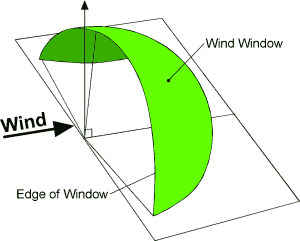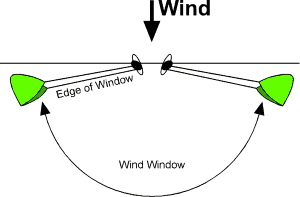The WIPIKA Guide Book
Download the original guide book in PDF (Portable Document Format) here. Use the free Adobe Acrobat Reader to view it (download the free Actobat Reader here)
Contents
Preparation
- Stand with your back to the wind, remove the wing from its bag and place the leading edge toward you with the battens facing up. Weight it down with sand.
- Clear the bridle and connect the flying lines to the bridle by inserting the stop knot into the slip-knot (red with red and green with green).
- Make sure there are no knots in the lines, as knots reduce the strength of the lines.
- Unwind and clear the flying lines.
- Attach them to the control system.
- Inflate the 5 cross battens first, then the leading edge.
- Put the bag, winder and pump away.
- Put the harness on or attach the control system to your craft.
Learning Process
It is mandatory to learn how to fly and steer a kite on land before using your Wipika for traction or going out to sea.

Take-off on land
- If you have an assistant, ask him to hold the wing by the middle of the leading edge at 100° to the wind.
- If you are by yourself, fold one of the tips of the wing up
to the first cross batten, then cover it with enough sand for the wing to stand still.

- In both cases, move to tension the lines with the wing on the side of the window of flight, almost crosswind.

- Check for loops or tangles in the lines and bridle.
- Move back to tension the lines. The wing gently takes flight.
- Learn to stabilize it a few feet off the ground, to rise and descend on the other side without landing.
Waterstart
The ideal practice-spot is shallow and with very small or no waves, so that you can crash the wing without any risk.
- Learn how to land and waterstart the wing in shallow water. Do it until you master this manoeuvre.
- If the wing lies flat, right side up or upside down, just let the wind tension the lines and unfold the wing. Then slowly pulling a couple feet left or right, let the wing get to the half-moon vertical position. It goes upwind up to the side of window of flight and, at this point, takes off when pulling the top line. Some finesse is required in piloting the wing.
Caution:
- Side-shore moderate winds are best for learning.
- Do not fly in dead off-shore wind conditions.
Landing
- If you have an assistant, lower the wing to ground level on the side of the window of flight and ask him to catch it by the leading edge only. Do not let anyone near the trailing edge or flying lines. It can be dangerous. Then release tension in the lines, walk up to the wing and weight it with sand or deflate it.
- If you are by yourself, place the wing above you then drop a
line. The wing luffs and falls down. Choose a clear landing spot with enough room to keep
lines clear of obstacles.
Caution: When you drop one line, do not let it take the bar or handle with it! The bar or handle could hit someone!
- Go to the wing, keeping the line tightened then weight it with sand or deflate.
To block the wing on the ground without excessive fluttering or chance to fly away, put it upside down, leading edge upwind and cross batten facing ground. Put sand along leading edge. In this position your wing can bear fairly strong winds.
Storage
- Pinch the valves to start deflation.
- Fold the wing and put it in its bag.
- Carefully rewind the lines and put the winder on a side of the bag.
- For those owning a Wipika boom, the winder is on it.
Bridle
The internal bridle consists of 2 main Dyneema lines (high modulus P.E.) and secondary lines, which are tensioned when one of the flying lines is pulled.
The wing is properly tuned when the internal bridle is under slight tension in flight, which means one only need to pull a few cm/inches of the main lines for the wing to react.
If the wing steers poorly, it's probably either because the internal bridle is not tensioned enough, or because the tubes are not inflated enough.
In case of the lines getting tangled, you can easily disconnect them at several locations, because all attachments feature a slip-knot and a stop knot.
Try to understand and memorize the internal bridle.
When and how to modify?
Generally, you will not have to modify the bridle. Do it only if you feel that your wing is difficult to control. For that, move the sliding knots along the stop knot lines. There are 6 knotted lines, 3 on each bridle side.
![[Bridle example 1]](images/bridle1a.gif)
Example 1: If you feel that the bridle lines (yellow) are slack and that your wing is difficult to turn, tighten the 2 bridle sides together as shown herebeing careful to follow the direction of the arrows indicated.
First adjust lines numbered 1 right and 1 left. If that is
insufficient, then adjust lines numbered 2 right and 2 left.
![[Bridle example 2]](images/bridle1b.gif)
Example 2: If your wing tends to fly too much to the left, check the line length between the wing tips and the boom. They must be exactly egual.
If the right line is too long, shorten it by making a knot near the boom, in the green line.
If the lengths are equal but the problem persists, tighten the right side bridle as shown here, first at point 2. If that is insufficient, then tighten at point 3.
